“Hindus are a majority in this Nation but they have developed a minority complexion”
-An excerpt from PM Atal Bihari Vajpayee’s speech in the Lok Sabha.
Dhulagarh, a West Bengal town 25 kilometers from Kolkata witnessed one of the most underreported large scale riots towards the fag end of the last year. A news channel which dared to report the incident where a Muslim mob plundered Hindu owned shops and caused the death of over a hundred Hindus even though the exact number could not be ascertained thanks to the apathy of Bengal Government which never bothered to rehabilitate the victims and left no stone unturned to make sure that the matter is given a cold shoulder so that there is no political backlash while a particular community is also appeased for electoral gains.
If you think that this was an aberration you are completely wrong, in fact there has been a chain of violent communal incidents ever since India became independent where the so called powerful majority was targeted and was followed by plain apathy by the State machinery and absurd silence by the media. A special feature of this narrative has been the defensive mindset of the Hindus who are desirous to be the ‘tolerant’ elements in the society and wish to remain either unaware or unmoved regarding the persecution of their community. The post 1947 narrative suggests that the psyche of India is that while an isolated act against a minority community is projected as a threat to the secular fabric of the country any riots where Hindus are killed is not a riot. Moreover, even if someone dares to rake up the injustice meted out to any class of Hindus he/ she is immediately branded a communal and Manuwadi Hindu by the self acclaimed intelligentsia.
Kashmiri Pandit Exodus, 1990 ethnic cleansing:
This incident of acute demographical alteration in the most sensitive State in India speaks volumes of the peculiar situation of India where the majority population lives in a fear that usually the minorities are subject to in certain pockets of the country. This was one of its kind communal outbreak in India for it not only included brutal killings of the Kashmiri Pandits who were an intrinsic part of the valley but it was also a proclamation by the Islamic extremists in the state that it is only the Muslims who will be allowed to live in the valley and that the Kashmiri Pandits won’t be allowed to live in the valley anymore even as the violent mobs screamed ‘Kashmir mein rehna hai to Allah hu Akbar Kehna hoga’. It wasn’t just a riot or communal violence but a systematic and unfortunately successful attempt to drive the victim community out of the valley.
The sudden violence which erupted in Kashmir on 20th January 1990 forced lakhs of Kashmiri Hindus to evict the valley and somehow migrate out of the clutches of violent Muslim mobs. According to the Indian Government, 62,000 Kashmiri migrant families still live in several parts of India and the State machinery has failed to restore them to their original home. Till date merely 1,800 Kashmiri Pandits have returned to the valley showing the lack of political will to carry out any proper rehabilitation and compensatory programmes for the victims. As a result, the size of the Pandit community in the Muslim majority State has shrunk from 1,40,000 in the period immediately before the exodus to less than 20,000 in the late 90s and further down to 3,400 in today’s time. This goes on to show that there was no healing process in place and the anti Hindu sentiment in Kashmir has only worsened in the last three decades with a little hope of the Government taking any concrete steps to restore the community to its original home.
The exodus of Kashmiri Pandits is the prime example of the anti Hindu narrative in India where even the worst form of communal violence against the Hindus is not paid much attention and somehow everyone seems to forget that India is a secular nation where every community must be treated equally.
While the Government gives up its responsibility of safeguarding the person and property of a particular community, the media does not ask any tough questions to those responsible for proper administration which the media would ask if the victims belong to any other religion and most importantly the Hindus seem to have somehow learned to be not offended by their own persecution and have compromised with the situation instead of asserting their rights.
Sources:
